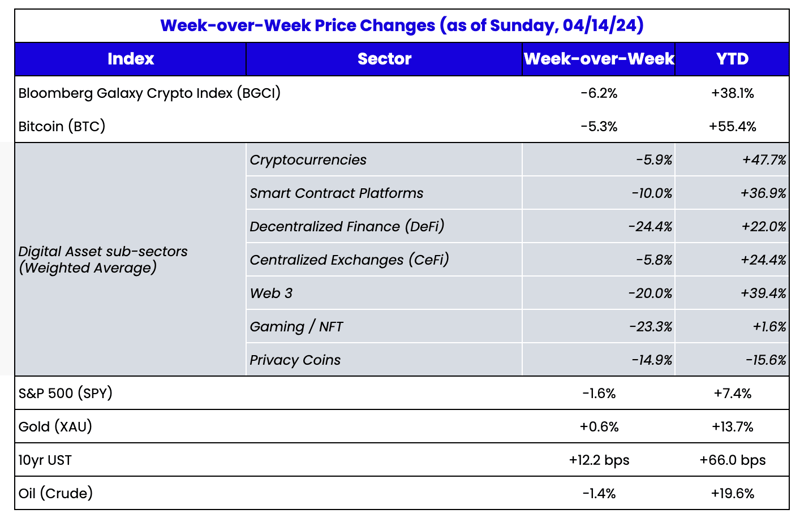
 Source: TradingView, CNBC, Bloomberg, Messari
Source: TradingView, CNBC, Bloomberg, Messari
Wars in the Middle East don’t matter for markets
This was a rough week for digital assets. While the overall market has been trading sideways for the past four weeks, the bottom finally fell out over the weekend. Bitcoin fell as much as 13% and Ethereum fell over 18% before bouncing back a bit Sunday. Many other assets, specifically in DeFi, fell as much as 40% from peak to trough. This 3-day move pushed many assets (40% of the top 50) back to negative returns YTD, which is a surprising data point to hear when most market participants have been discussing “what stage of the bull market are we in?”. Perhaps the answer is, “let’s stop trying to define bull and bear markets”.
Now, we know that the tensions in the Middle East, and specifically the attack on Israel from Iran, sparked the sell-off. The timing of the two large moves lower (first Friday morning and again Saturday afternoon) happened immediately following the attacks and subsequent headlines of more attacks. There’s no doubt that the headlines triggered the selling. That said, fear of a war in the Middle East is NOT the reason markets are lower. A trigger, yes, but it was simply the straw that broke the camel’s back. Wars generally don't matter for medium to long-term risk assets. The chart below shows equity markets six months prior (two months prior are shaded in gray) and 18 months after recent invasion events. Digital assets are no more affected by wars than equities are.
So, while the war headlines spooked markets enough to induce selling, the reasons why crypto markets are weak have more to do with a cumulative effect of the past few week’s news, including:
- Higher than anticipated inflation print
- A reduction of expected Fed rate cuts this year
- A slowdown in BTC ETF inflows
- An assumed rejection of an ETH spot ETF
- Uniswap receiving a Wells notice from the SEC
- Unsustainable memecoin advances in place of real project growth
- Solana’s blockchain having performance issues
- Tax day in the U.S., which often leads to selling crypto assets to make payments
So we can expect a full retracement of the “war selloff”, all else equal. But perhaps there will be new reasons for the market to stay lower (or at least not to advance higher).
18 ways that we can compare crypto to my day at the Masters
This weekend, I had the opportunity to attend the Masters with a group of other digital asset fund managers courtesy of Galaxy Digital. Spending two days at the beautiful Augusta National Golf Club made me think about how the digital assets industry compares to other aspects of life.
- Everyone thinks they are an expert even though only 89 actual experts play golf. The peanut gallery constantly advised on grips, backswings, where to land the ball, and what club to use. Similarly, there are a select few people in the world who have dedicated their lives and careers to learning blockchain and digital assets. Still, so many talking heads like Nouriel Roubinis, Warren Buffets and Jamie Dimons continue to offer their opinions despite not having any expertise in the matter.
- I was in awe of the actual experts. They are just so talented. Even though I, too, golf, I can’t golf like that. Similarly, I’m in awe of some wallet forensic experts, great DeFi traders and farmers. Yes, I can read a blockchain explorer and navigate DeFi applications, but not like those professionals uncovering unbelievable data in the ledger and utilizing blockchain to make fortunes.
- I walked the entire course. It is incredibly long, hilly and challenging. You can’t truly appreciate how hard it is for these players to walk this course and still make golf shots unless you see it in person and do it yourself. Similarly, unless you are using blockchain applications, trading on DeFi apps, farming and staking, you can’t truly understand how challenging the digital assets world is. Having a passive investment in an ETF is like watching the Masters on TV – it’s fine, but it does not tell the whole story.
- I constantly tried to find a good view of the action—leaning over ropes, getting behind short people standing on my tippy toes, and navigating around bleachers. Similarly, as digital asset investors, we’re constantly trying to find new valuation techniques and new ways to understand and explain different tokens and use cases.
- Golfers are amazingly resilient when they make bad shots or get bad bounces. When they look dead, they often find a way to make par. Similarly, the digital assets markets are constantly left for dead by mainstream media and “no coiners”, only to find a way to bounce back better than ever.
- Sometimes, an innocent bystander gets hit with a ball and is rushed to the hospital. I saw one guy break his hand when he was struck with an errant shot. It was all anyone talked about for hours, but it’s not the norm. The one-off occurrence makes headlines but is not representative. Similarly, occasionally, someone gets their wallet hacked, or an innocent investor gets taken advantage of by a pro, but this is not the norm just because everyone talks about it.
- People can run around the course and do whatever they want, but most people don’t. They follow unwritten rules, adhere to ropes and signs, and are respectful of the golfers and other people. Occasionally, someone runs afoul, but again, it is not the norm. The digital assets market operates the same way. There are fewer barriers to entry, fewer roadblocks, and less established rules, but most market participants are operating under an unwritten rule of compliance and respect, even if a few bad apples seem to be trying to ruin the industry’s reputation.
- The media are like vultures. I followed a lesser-known 3-some from Hole 1 to Hole 18 on Thursday. In the beginning, there was no one following them. But then they started playing well. All 3 players were 2 under par through the 8th hole. Then, the media started buzzing. Each golfer had a cameraman following them. Similarly, as soon as some obscure coin starts trading up in crypto, the media can’t stop talking about it. They flock to it like a hot craps table.
- It felt really good that I randomly picked a good group to follow. It was like identifying a band early, or a comedian early, or a new token or stock. Then, the crowd and media showed up and ruined my experience. Eventually, these players started to play badly on the back 9 (perhaps due to the increased attention). I defended them and rooted hard for them to turn it around. It reminded me of doubling down on a declining memecoin or convincing myself that some token that is not working will suddenly come back from the dead. There is a powerful cognitive bias with being invested, whether with money or time.
- I was often completely lost without good commentary like I’m used to on TV. I often had no idea why there were 10-minute pauses before a golfer hit or what a player talked about with their caddie. While it was fun to be there in person, I missed the expert commentary helping me through it. Similarly, most digital asset investors need experts to write articles and speak to the media so casual investors can more easily decipher what is truly important in the market.
- The food at the Masters was terrible, but it was so cheap that I kept eating it. I ate five sandwiches in one day just because they were cheap and it was fun to try them. It reminded me of chasing low-priced coins, or memecoins, and buying way too many of them just because of the low cost and the experience.

- Though golfers were clearly competing against each other, there was a comradery among players who teamed up together. Opponents helped each other on the course—reading putts, adjusting for wind, and sharing past experiences on this hole. Similarly, crypto is very collaborative, even between funds that are competing with each other. Just because someone may do better than you doesn’t mean you can’t help them do their best.
- As I walked the course, I often stopped to look backward. The view was different when you turned around. What looked like an easy hole walking one way looked much more challenging when turning around. Similarly, sometimes we must look back at how far we’ve come in blockchain to truly appreciate the path and the difficulty.
- Plenty of old men in suits (rules judges) were hiding in the bushes, who only occasionally came out to help the players understand a rule that wasn’t initially clear. Players needed help on where to drop the ball, how far they could move a ball, and many other questions that I couldn’t decipher. It seemed no one truly understood the rules. This reminded me of the old men in suits at the SEC. They are always there hiding in the weeds, ready to come out and “help,” but it would be much easier if the rules were established and communicated upfront.
- There are no phones on the course. This was incredibly liberating but also terrifying. Similarly, untethering yourself from banks seems terrifying, but it is actually quite freeing.
- FOMO – the Masters experience was amazing. At one point, I enjoyed the play so much that I didn’t want to leave to get water even though I was exhausted and thirsty. But 18 different groups are playing at the same time across the course. It’s physically impossible to see everything, but I felt like I was missing out every time I heard the crowd roar because someone hit a great shot. FOMO is real, but it’s impossible to do everything. In general, I found that it was not wise to follow the crowds. Every time I tried to follow a crowd, I ended up disappointed, got there late, or couldn’t see. I think you know where I’m going with this one.
- The Masters was a perfect combination of old school and new tech. Golf hasn’t changed much in a century, and neither has Augusta. But sprinkled into the course were all sorts of new cameras mining data. Bryson DeChambeau even used custom-made 3-D printed irons. Similarly, blockchain technology is brand new, but in some ways, the industry is just recreating finance and gaming in ways that have been around for centuries. We always say that blockchain is an evolution, not a revolution.
- Many people think golf is a waste of time and land. It’s boring. It’s definitely not for everyone. But I loved it. I respect others’ opinions, but I disagree.
Just like crypto. It ain’t for everyone, but it’s pretty awesome.


 Source: TradingView, CNBC, Bloomberg, Messari
Source: TradingView, CNBC, Bloomberg, Messari